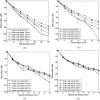Comparison of electrohysterogram signal measured by surface electrodes with different designs: A computational study with dipole band and abdomen models
- PMID: 29229922
- PMCID: PMC5725603
- DOI: 10.1038/s41598-017-17109-3
Comparison of electrohysterogram signal measured by surface electrodes with different designs: A computational study with dipole band and abdomen models
Abstract
Non-invasive measurement of uterine activity using electrohysterogram (EHG) surface electrodes has been attempted to monitor uterine contraction. This study aimed to computationally compare the performance of acquiring EHG signals using monopolar electrode and three types of Laplacian concentric ring electrodes (bipolar, quasi-bipolar and tri-polar). With the implementation of dipole band model and abdomen model, the performances of four electrodes in terms of the local sensitivity were quantified by potential attenuation. Furthermore, the effects of fat and muscle thickness on potential attenuation were evaluated using the bipolar and tri-polar electrodes with different radius. The results showed that all the four types of electrodes detected the simulated EHG signals with consistency. That the bipolar and tri-polar electrodes had greater attenuations than the others, and the shorter distance between the origin and location of dipole band at 20 dB attenuation, indicating that they had relatively better local sensitivity. In addition, ANOVA analysis showed that, for all the electrodes with different outer ring radius, the effects of fat and muscle on potential attenuation were significant (all p < 0.01). It is therefore concluded that the bipolar and tri-polar electrodes had higher local sensitivity than the others, indicating that they can be applied to detect EHG effectively.
Conflict of interest statement
The authors declare that they have no competing interests.
Figures







Similar articles
-
Non-invasive electrohysterogram recording using flexible concentric ring electrode.Annu Int Conf IEEE Eng Med Biol Soc. 2014;2014:4050-3. doi: 10.1109/EMBC.2014.6944513. Annu Int Conf IEEE Eng Med Biol Soc. 2014. PMID: 25570881
-
Feasibility and analysis of bipolar concentric recording of electrohysterogram with flexible active electrode.Ann Biomed Eng. 2015 Apr;43(4):968-76. doi: 10.1007/s10439-014-1130-5. Epub 2014 Oct 2. Ann Biomed Eng. 2015. PMID: 25274161
-
Comparison of non-invasive electrohysterographic recording techniques for monitoring uterine dynamics.Med Eng Phys. 2013 Dec;35(12):1736-43. doi: 10.1016/j.medengphy.2013.07.008. Epub 2013 Aug 16. Med Eng Phys. 2013. PMID: 23958388
-
[Mechanical and electrical uterine activity. Part I. Contractions monitoring].Ginekol Pol. 2008 Nov;79(11):791-7. Ginekol Pol. 2008. PMID: 19140504 Review. Polish.
-
Accuracy of frequency-related parameters of the electrohysterogram for predicting preterm delivery: a review of the literature.Obstet Gynecol Surv. 2009 Aug;64(8):529-41. doi: 10.1097/OGX.0b013e3181a8c6b1. Obstet Gynecol Surv. 2009. PMID: 19624864 Review.
Cited by
-
A Novel, Cardiac-Derived Algorithm for Uterine Activity Monitoring in a Wearable Remote Device.Front Bioeng Biotechnol. 2022 Jul 19;10:933612. doi: 10.3389/fbioe.2022.933612. eCollection 2022. Front Bioeng Biotechnol. 2022. PMID: 35928952 Free PMC article.
-
Polygonally Meshed Dipole Model Simulation of the Electrical Field Produced by the Stomach and Intestines.Comput Math Methods Med. 2020 Oct 21;2020:2971358. doi: 10.1155/2020/2971358. eCollection 2020. Comput Math Methods Med. 2020. PMID: 33178331 Free PMC article.
References
Publication types
MeSH terms
LinkOut - more resources
Full Text Sources
Other Literature Sources
Miscellaneous

